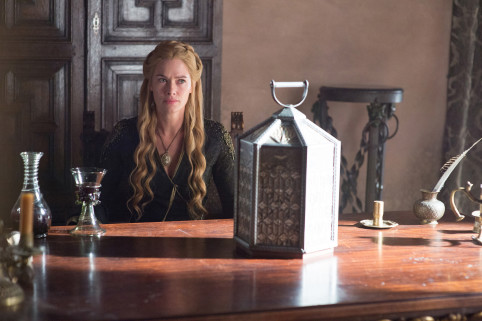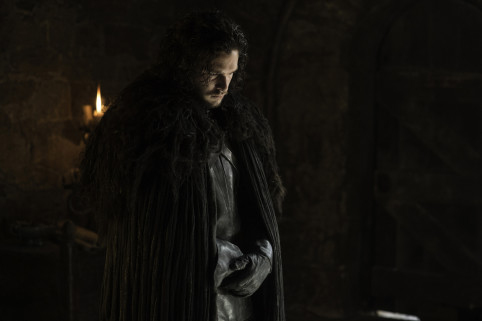Spoilers for the second episode of Season 5 of Game of Thrones follow, obviously.
We’ve reached a fascinating point in the Game of Thrones television series: Not only is the show departing dramatically from the plot of the books, but they’re starting to catch up to them, and even move beyond them.
Throughout this season I’ll be recapping Game of Thrones and dissecting the changes between the show and the books, and I’ll do my best not to spoil any important plot points. But again, we’re entering thorny and uncharted territory here, where we won’t always know what a spoiler really is—or what the “real” story is.
This week, we find out if Arya made it across the Narrow Sea (she did), if Daenerys can maintain order in Meereen (um, perhaps?), if Sansa wants Brienne’s protection (eh, not so much), and if Jon Snow will be a bastard forever (maybe not!). Get ready.
Arya
She’s back, baby. After offering the mysterious coin from her many-faced friend Jaqen H’ghar to a Braavosi sailor, she’s crossed the Narrow Sea, and arrived at a mysterious location in Braavos: The House of Black and White. She knocks on the massive double doors, and an old man answers. She presents him with the coin, only to be told that there’s no one there by that name Jaqen. She spends the night in the rain outside, recites her little list of death, which has dwindled to only four names. (Hey, maybe it’s working.) The next morning, she throws the coin into the sea and heads out into the streets of Braavos. It doesn’t take long before she’s accosted by three men who want to steal her sword, Needle—the one Jon gave her so long ago.
“Turn around, and go,” she says with steely eyes, moving into the fighting stance that Syrio Forel taught her. “Nothing’s worth anything to dead men.” She could probably take one of them, maybe two. Not sure about three. But before she has to do anything, the old man from the House appears behind her, and the men flee at the site of him. Interesting. She follows him back to the House of Black and White, where he returns the coin she dropped in the ocean and reveals a familiar face: Jaqen H’ghar. He insists that he told the truth, that Jaqen doesn’t live there, that he is no one. “And that is what a girl must become.” And so Arya enters the House of Black and White.
In the books: The sailor who takes Arya to Braavos is named Ternesio Terys. She was allowed inside immediately when she knocked at the door with the coin and meets a man there. Although he can change his appearance, he never reveals himself as Jaqen—at least he hasn’t so far—though there is a character elsewhere in A Feast for Crows whom some readers think might be Arya’s former murder friend. Also, her hit list is two people longer in the books, and includes Raff the Sweetling, the torturer from Harrenhal, and Ilyn Payne, the man who beheaded her father.
Sansa and Brienne
Sansa and Littlefinger continue their journey to Somewhere, stopping to rest at an inn on the way. Guess who happens to be at the very same inn? Brienne and Pod! After they spot young Lady Stark—and count the number of knights around her—Brienne sends Pod to ready the horses, and approaches the girl she’s been chasing for so very long. She reveals herself as the Sworn Sword of Catelyn Stark, and pledges her life to Sansa’s protection. Littlefinger, who is basically a walking, talking raised eyebrow, is a bit more skeptical. He brings up the death of Renly, and forces Brienne to recount the story of his death at the hands of a shadow, which he knows will make her sound ridiculous. I don’t think he doubts Brienne’s sincerity, necessarily—I just don’t think that she fits into his plans for Sansa, whatever they are. Sansa seems equally skittish—remember that time when she saw Brienne kneeling to Joffrey at his wedding?—and quietly declines her service. Littlefinger remarks that he doesn’t want Brienne “wandering the countryside alone”—which is how nobles say they’re taking you captive—but the fearsome Maid of Tarth has already had more than her share of being a prisoner, so carnage ensues.
She takes out the first couple knights with her fists, cuts down a few more with a sword once she gets on her horse, and leads the rest on a chase through the woods that ends with most of them dead. When she reunites with her squire, Pod says that since both Stark girls have refused her service, that she’s probably released from her vow. But Brienne isn’t ready to release herself: “Do you think she’s safe with Littlefinger?” I mean, that’s a really complicated question, and one I’m not sure I know the answer to, either. So she decides to keep following them, because that’s what Brienne does.
In the books: Again, Sansa never left the Eyrie, and Brienne never met up with Sansa, at least in the books we’ve read so far. (I’m probably going to end up saying that a lot in the weeks to come.)
 Helen Sloan/HBO
Helen Sloan/HBO
Cersei
A very interesting gift has arrived from Dorne: one of Myrcella’s necklaces, mounted on a statue of a snake. Naturally, she interprets it as a threat: “Our daughter is in Dorne surrounded by people who hate our family,” she tells Jaime. “They blame us for the death of Oberyn and his sister.” She rants for a while about burning Dorne to the ground, because really she’s the snake that Daenerys described last episode: the one that lashes out when it gets angry, and only makes itself more vulnerable. And boy, does Cersei feel vulnerable. Her eldest son and father have been murdered, she believes her hated brother killed both of them, her other son is marrying a woman she hates, and her only daughter is being held captive by people who hate her just as much.
Jaime decides to make a last, grand gesture to win back his sister/lover: He’s going to Dorne, and he’s going to take Myrcella back. Not with an army, but by sneaking into the Water Gardens himself. Cersei seems skeptical, but seems quietly pleased. He won’t be alone, however; he quickly recruits sellsword Bronn to come with him, though he’s Ser Bronn now, for his service to Cersei. He’s about to be married to a nice, chatty, vaguely noble girl with hair the color of straw. Jaime has a better offer: come with him to Dorne, and come back to “a much better girl, and a much better castle.”
Cersei, meanwhile, is collecting the heads of every little person in the kingdom, but of course none of them are Tyrion. She’s also taken her place on the Small Council as the Hand of the King—insisting, of course, that she’s just a proxy for Tommen, since of course it would never be appropriate for a woman to take on such an important role. She tries to quell dissent with a series of promotions: Lord Tyrell is made Master of Coin, Qyburn replaces Varys as Master of Whisperers, and she appoints her uncle Kevan as Master of War. Unfortunately, Kevan is not quite as susceptible to her flattery and bribery: “I do not recognize your authority to dictate what is and is not your concern,” he says, storming out. “You’re the Queen Mother, and nothing more.”
And listen: Cersei might not actually be very good at leading, but this is absolutely, 100 percent sexism. No one would ever question Jaime this way if he’d decided to sit down at the table instead. Hasn’t there always been some old man in Cersei’s way, trying to tell her she couldn’t didn’t do the things she wanted because she didn’t have the right parts? If Jaime had been born a girl, would he have been any more patient?
In the books: Although Cersei does worry for Myrcella, Jaime never goes to Dorne, with Bronn or otherwise. Bronn does end up marrying a noblewoman: Lollys Stokeworth who was raped and impregnated during the mob attack in King’s Landing. Cersei initially asks Jaime to be Hand of the King, but he refuses her. When she asks Kevan, he also refuses, and says he will only be Hand if she goes back to Casterly Rock—where he says Tywin was already planning to send her—and makes him Regent in her place. He also gives an amazing speech about how she’s as unfit as a ruler as she is as a mother, She throws a cup of wine in his face. It’s great.
Ellaria Sand
Oberyn’s paramour has made her way back to Dorne, and she wants revenge. His brother, Prince of Dorne Oberyn Martell—aka Dr. Julian Bashir of Star Trek: Deep Space Nine—is unwilling to give it to her, however. The gout-stricken rules tell her that a death by combat isn’t a murder, and while he’s sad too, she needs chill. But she cannot! She insists that she wants war, Oberyn’s warrior daughters the Sand Snakes want war, the whole country wants war! “Then we are lucky the whole country does not decide,” says Oberyn. Turns out Cersei was right to worry about Myrcella: Ellaria wants to punish her for her family’s crimes, and send her back to Cersei, one finger at a time. Oberyn insists that while the Lannisters might be the worst, they’re not going to mutilate little girls for vengeance while he’s ruling Dorne. “And how long will that be?” Ellaria wonders.
In the books: Although Ellaria returns to Dorne, she isn’t the one who challenges Doran. Instead it is Obara Sand, the eldest of the Sand Snakes. Unlike the slim Doran we see onscreen, the one in the book is described as very overweight, with grotesquely gouty legs.
 HBO
HBO
Daenerys
Daario walks through the streets of Meereen with Grey Worm, talking about the differing approaches of their military orders. The Unsullied might be the Spartans of Essos, but the Second Sons like to play things a little faster and looser: drinking, blending in, and conducting espionage. That’s how they find themselves at a house that the fearless Grey Worm believes is empty. “That’s your problem,” says Daario. “Someone who’s forgotten fear has forgotten how to hide. He stabs his knife into the wall, and out falls a Son of the Harpy. Back in the Great Pyramid, they debate his fate; one of her advisors, a former slave named Mossador, wants him executed, though he also admits that he’s probably just a poorer man paid off by the noble families to do their dirty work. Ser Barristan reminds Dany of her father, the vengeful Mad King of Westeros, who “gave his enemies the justice he thought they deserved.” That worked right up until his cruelty resulted in the end of the Targaryen dynasty, and the deaths of everyone in her family, except her. She agrees to the trial.
Unfortunately, it doesn’t matter because Mossador goes to his cell, murders the man about to stand trial anyway, and nails him to a wall next to blood-soaked graffiti that reads: KILL THE MASTERS. He later tells Daenerys that he did it for her, that he thought it was what she really wanted, but her hands were tied. Perhaps, he was counting on her mercy. Unfortunately, he’s not going to get it. In yet another political blunder, she has him executed publicly—infuriating all the former slaves who once called her “mother.” So I guess everyone’s angry with her now. Turns out that occupying a city isn’t quite as easy as conquering it, eh?
She wanders out to a balcony to think about what she’s done, and guess who she finds waiting for her but Dorgon, her great black dragon. She almost touches him, but then he disappears again, flying out over the city of Meereen on his great black wings.
In the books: Rather than an advisor to Daenerys and former slave of Meereen, Mossador was actually Missandei’s brother—and one of the Unsullied warriors who died in the attacks by the Sons of the Harpy. Instead, it is Skahaz mo Kandaq who insists that there needs to be punishment for the attacks, although he wants to execute one man from every one of the noble families who oppose her.
Barristan Selmy’s speech about the Mad King mentions fathers being murdered before their sons—most famously, he had Ned Stark’s father, Lord Rickard, cooked alive in his own armor, while his son—Ned’s brother, Brandon—was placed in a noose and strangled as he strained to save his father. That’s why Ned teamed up with his pal Robert and took down the Targaryens, so it didn’t end well for anyone.
Tyrion
Tyrion is drinking en route to Volantis, which is en route to Meereen. He complains to Varys that he’s basically stuck in another box on wheels, and wants to take a walk. Varys refuses, since little people are not exactly common and Cersei’s collecting their heads like Pokemon cards. Probably, they’re all cursing his name, because that’s how Tyrion’s life works. Somehow, it becomes a conversation about how well Tyrion acquitted himself as Hand of the King. “You were quite good you know, at ruling.” Perhaps that’s the long game for Varys: If he can get Daenerys on the throne, perhaps Tyrion could bring his family name and his political savvy to actually help her rule—the role that she’s finding ever so challenging right now in Meereen.
In the books: We don’t know where Varys went, but he and Tyrion don’t travel together after he arrives in Essos.
 Helen Sloan/HBO
Helen Sloan/HBO
Jon
Young Shireen Baratheon continues her campaign for literacy, now teaching Gilly how to read in the stacks of Castle Black. Sam muses aloud about how the youngest Lord Commander was Osric Stark, an ancestor of Jon’s who was elected at the age of 10. Gilly is not enthused by his disruptive trivia, and tells him she hopes he’s having fun with “Ostrich Stark.” Someone … please draw that. Selyse comes down and kicks Gilly and Sam out, and tells Shireen to stay away from the wildling girl. After all, her father did just defeat them and burn their king alive. Gilly’s nice and all, but given everything we’ve seen on the show, that’s pretty reasonable.
Stannis is still pretty pissed about Jon showing mercy to Mance Rayder, but he’s uncharacteristically going to let it slide as he has other plans for the Stark bastard. After writing to the Northern folk on Bear Island and asking for their allegiance, Stannis received a reply: “Bear Island knows no king but the King in the North, whose name is Stark.” Jon observes that Northerners can be a bit like the free folk—clannish, and fiercely loyal. No wonder he got along so well with them. Stannis says he has a solution that may please them all: “Kneel before me, lay your sword at your feet, pledge me your service and you’ll rise again as Jon Stark, Lord of Winterfell.”
Jon’s eyes grow wide, because it’s everything he ever wanted, growing up in the shadow of Robb Stark. Of course, he tells Sam later that he’s going to refuse it because HONOR and VOW and NED STARK. Christ. Why can’t anything I want ever happen on this show, ever? Then it’s time for the election for the new Lord Commander of the Night’s Watch, and after Maester Aemon breaks the tie … Jon wins.
In the books: The election for Lord Commander originally took place before Mance Rayder was burned, but Jon did indeed win.